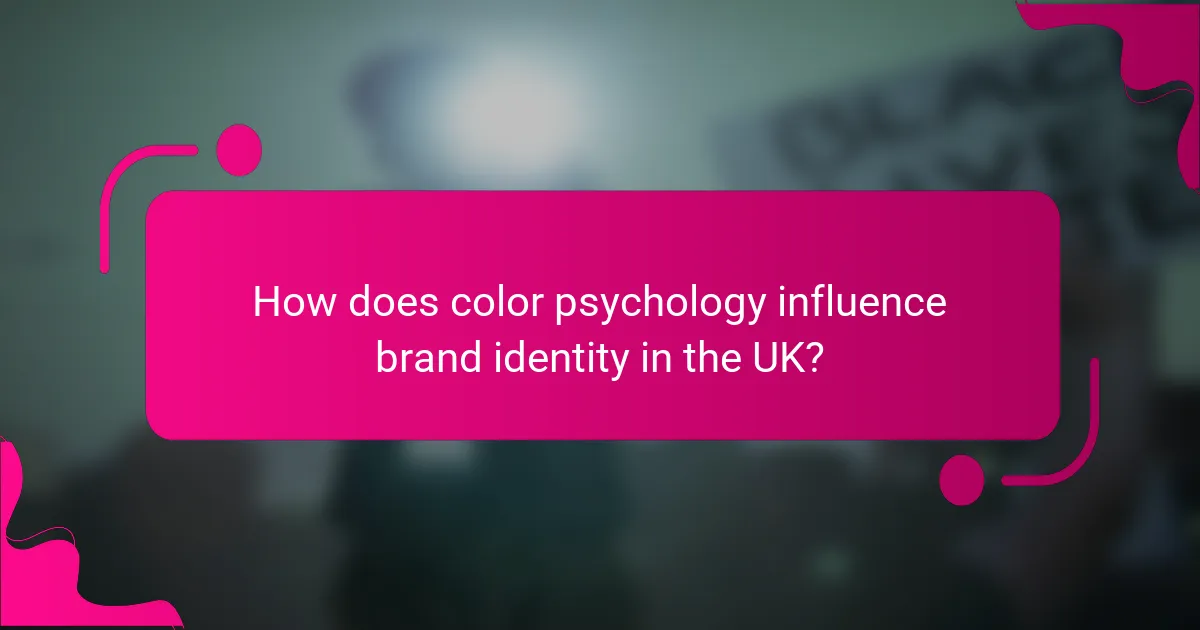Color psychology plays a crucial role in shaping brand identity by influencing consumer perceptions and emotional connections. Selecting the right color palette can evoke specific feelings and associations, ultimately impacting purchasing decisions and fostering brand loyalty. By understanding the psychological effects of colors and aligning them with audience preferences, businesses can create a compelling and resonant brand identity.

How does color psychology influence brand identity in the UK?
Color psychology significantly shapes brand identity in the UK by affecting how consumers perceive and connect with brands. The right color palette can evoke specific emotions and associations, ultimately influencing purchasing decisions and brand loyalty.
Emotional associations with colors
Different colors evoke distinct emotional responses, which can be leveraged in branding. For example, blue often conveys trust and reliability, making it popular among financial institutions, while red can evoke excitement and urgency, frequently used in sales promotions.
Understanding these emotional associations helps brands select colors that align with their desired image and messaging. For instance, green is commonly associated with health and sustainability, appealing to eco-conscious consumers.
Case studies of UK brands
Several UK brands effectively utilize color psychology to enhance their identity. For example, the banking giant Barclays uses blue to project stability and trustworthiness, while the fast-food chain McDonald’s employs red and yellow to stimulate appetite and create a sense of urgency.
Another example is the organic food retailer Whole Foods, which uses earthy tones like green and brown to emphasize its commitment to natural and sustainable products, resonating with health-focused consumers.
Impact on consumer perception
Color choices can significantly impact consumer perception and behavior. Research indicates that up to 90% of snap judgments about products can be based on color alone, highlighting its importance in marketing strategies.
Brands that align their color schemes with their target audience’s preferences can enhance brand recognition and loyalty. For instance, a brand targeting younger consumers may opt for vibrant colors to convey energy and modernity, while a luxury brand might choose muted tones for sophistication.

What are effective color palettes for branding?
Effective color palettes for branding are combinations of colors that evoke specific emotions and align with a brand’s identity. A well-chosen palette can enhance brand recognition and influence consumer perceptions, making it crucial for businesses to select colors that resonate with their target audience.
Popular color combinations
Some popular color combinations include blue and white, which convey trust and professionalism, and red and yellow, often associated with energy and excitement. Green and brown can evoke feelings of nature and sustainability, while black and gold suggest luxury and sophistication.
When selecting a color combination, consider the emotional impact each color has. Aim for a balance that reflects your brand’s values and appeals to your audience’s preferences.
Industry-specific palette examples
In the tech industry, blue and gray are frequently used to communicate reliability and innovation. For health and wellness brands, greens and soft pastels can create a calming and nurturing atmosphere. Meanwhile, food and beverage brands often utilize vibrant colors like orange and red to stimulate appetite and excitement.
Understanding industry trends can guide your palette selection, ensuring your brand stands out while still fitting within familiar visual cues that consumers expect.
Tools for palette selection
There are several online tools available for selecting color palettes, such as Adobe Color, Coolors, and Canva’s color palette generator. These platforms allow users to explore various combinations and see how colors interact with one another.
When using these tools, consider testing your palette on different backgrounds and in various applications, such as logos and marketing materials, to ensure versatility and effectiveness across different mediums.

How can businesses select colors for their target audience?
Businesses can select colors for their target audience by understanding the psychological impact of colors and aligning their palette with the preferences and demographics of their customers. This involves researching audience characteristics and regional trends to create a visually appealing and emotionally resonant brand identity.
Understanding audience demographics
Understanding audience demographics is crucial for effective color selection. Factors such as age, gender, income level, and cultural background influence how individuals perceive colors. Businesses should conduct market research to identify the specific demographics of their target audience to tailor their color choices accordingly.
For example, a brand targeting young adults may opt for vibrant and bold colors, while a company focusing on seniors might choose softer, more muted tones. This alignment helps create a connection with the audience and enhances brand recognition.
Color preferences by age and gender
Color preferences can vary significantly by age and gender, impacting how businesses should approach their palette selection. Generally, younger audiences tend to favor bright and energetic colors, while older consumers may prefer more subdued and classic shades.
Gender also plays a role in color preference. Studies suggest that women often gravitate towards softer colors like pastels, while men may prefer bolder, darker hues. Brands should consider these trends when designing marketing materials and product packaging to resonate with their intended audience.
Regional color trends in the UK
Regional color trends in the UK can influence consumer behavior and brand perception. For instance, colors associated with British heritage, such as deep greens and rich reds, may evoke a sense of tradition and reliability, appealing to local consumers.
Additionally, current fashion and design trends can shift color preferences. Brands should stay updated on seasonal color palettes and popular trends in the UK market to ensure their color choices remain relevant and appealing to consumers.

What role does color play in marketing campaigns?
Color plays a crucial role in marketing campaigns by influencing consumer emotions and perceptions, ultimately affecting purchasing decisions. The right color palette can enhance brand recognition, evoke specific feelings, and create a memorable experience for the audience.
Color impact on ad performance
The impact of color on ad performance is significant, with studies showing that color can increase brand recognition by up to 80%. Colors can evoke emotions that align with the campaign’s message, such as blue for trust or red for urgency, which can lead to higher engagement rates. Marketers should consider the psychological effects of colors when designing advertisements to maximize their effectiveness.
Additionally, contrasting colors can draw attention to key elements in an ad, such as calls to action. Using a color wheel can help marketers choose complementary colors that enhance visibility and appeal.
Examples of successful campaigns
Many successful campaigns have effectively utilized color to resonate with their target audience. For instance, Coca-Cola’s use of red evokes excitement and energy, aligning perfectly with their brand image. Similarly, Tiffany & Co. employs a distinctive shade of blue that signifies luxury and exclusivity, reinforcing their brand identity.
Another example is the use of green by Whole Foods, which conveys freshness and health, appealing to environmentally conscious consumers. These examples illustrate how color choices can directly impact brand perception and consumer behavior.
Color testing methods
To determine the most effective color palette for a campaign, marketers can employ various color testing methods. A/B testing is a common approach, where two versions of an ad are created with different color schemes to see which performs better in terms of engagement and conversion rates.
Another method is focus group testing, where participants provide feedback on color preferences and emotional responses. Online surveys can also be utilized to gather data on consumer perceptions of color in relation to brand messaging.

What are the psychological effects of colors?
Colors have significant psychological effects, influencing emotions, perceptions, and behaviors. Different hues can evoke specific feelings and associations, making color selection crucial in design and branding.
Color meanings and emotions
Each color carries its own set of meanings and emotional triggers. For instance, red often symbolizes passion or urgency, while blue is associated with calmness and trust. Understanding these associations helps in selecting colors that align with the desired emotional response.
When creating a color palette, consider the context and target audience. For example, vibrant colors may energize a youthful brand, while muted tones might resonate better with a luxury product. Testing color combinations can reveal how they interact and affect perception.
Research studies on color psychology
Numerous studies have explored how colors impact human behavior and decision-making. For example, research indicates that people may be more likely to purchase products in red packaging compared to blue, as red can create a sense of urgency. Such findings highlight the importance of color in marketing strategies.
Additionally, studies show that colors can influence mood and productivity. For instance, green environments are often linked to increased creativity and focus. Brands can leverage these insights to enhance customer experiences and improve engagement through thoughtful color choices.

How to create a color strategy for your brand?
Creating a color strategy for your brand involves selecting colors that align with your brand identity and resonate emotionally with your target audience. A well-defined color palette can enhance brand recognition and influence consumer behavior.
Steps to develop a color strategy
Begin by researching your target audience to understand their preferences and emotional responses to colors. Consider conducting surveys or focus groups to gather insights about color associations.
Next, analyze your competitors to identify color trends within your industry. This can help you differentiate your brand while ensuring you remain relevant. Aim for a palette that reflects your brand values and mission.
Finally, create a color palette that includes primary, secondary, and accent colors. Ensure that the colors work well together and can be applied consistently across various platforms, from digital to print.
Frameworks for color selection
Several frameworks can guide your color selection process. The Color Wheel is a fundamental tool that illustrates how colors relate to one another, helping you choose complementary or analogous colors for your palette.
The Psychology of Color framework emphasizes the emotional impact of colors. For example, blue often conveys trust and professionalism, while red can evoke excitement and urgency. Align your color choices with the emotions you want to elicit from your audience.
Lastly, consider using the 60-30-10 rule for color distribution in design. Allocate 60% of your palette to a dominant color, 30% to a secondary color, and 10% to an accent color. This approach creates visual balance and harmony in your branding materials.
